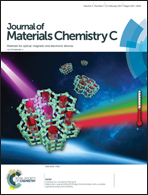Cryogenic magnetocaloric effect in zircon-type RVO4 (R = Gd, Ho, Er, and Yb)†
Abstract
Low-temperature magnetic refrigeration has attracted the attention of the cryogenics research community in the areas of technology in space science and in the liquefaction of hydrogen or other fuel gases, although it has been less researched compared to room-temperature magnetic refrigeration. Here, we report that the RVO4 (R = Gd, Ho, Er, and Yb) series is promising for low-temperature cryogenic refrigeration. GdVO4 is the most promising material, exhibiting a maximum magnetocaloric effect (ΔSmaxM) of 41.1 J kg−1 K−1 at 3 K for a change in field (ΔH) of 50 kOe. The values of ΔSmaxM are also promising, with 7.94 J kg−1 K−1 at 15 K, 19.7 J kg−1 K−1 at 2 K, and 17.4 J kg−1 K−1 at 2 K with ΔH = 50 kOe for HoVO4, ErVO4, and YbVO4, respectively. The maximum value of adiabatic temperature change (ΔTmaxad) attributed to the large magnetocaloric effect is 18 K for GdVO4 with ΔH = 50 kOe. The results further indicate that demagnetization with 50 kOe field close to the liquid hydrogen temperature at 20.3 K leads to the remarkable decrease of temperature to 3.5 K. Satisfying its potential as a refrigerant material, the thermal hysteresis of magnetization is negligible, and the values of ΔSmaxM and ΔTmaxad are as high as 12.4 J kg−1 K−1 and 8.5 K for 20 kOe change in field, which can be achieved without a superconducting magnet.



 Please wait while we load your content...
Please wait while we load your content...